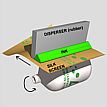
Economical for one colour decoration and small runs. Double cost for two colours because each colour is applied in a separate step.
Epoxy-inks can be used for protection against scratching, and for use with products that attack standard enamel inks. Ultra-violet inks are very resistant to scratches and dries quickly.
Danish Name
Category
Materials
Epoxy-ink
Enamel-ink
UV-ink
Substrates:
Plastics
Ceramics
Typical products
Transparent label
Competing processes
ReferencesLerman Container Company
Willumsen A/S
Price notes
| DKK/part*color | 5 parts | 500 | 10000 |
| Smooth surfaces | 150 | 2 | 0.3 |
| Rough surfaces | 150 | 2.3 | 0.45 |
| Large (10m2) | 750 | 650 | 500 |
Price date
Additional info
Cliché: 450 DKK. Machines set-up 270-300 DKK, paid only for production volumes lower than 1000 parts (manual), 10000 (automatic).
Photo
Copyright
This page is part of Design inSite
Disclaimer